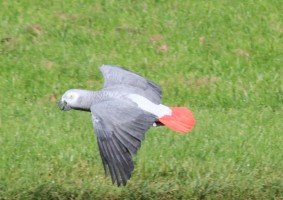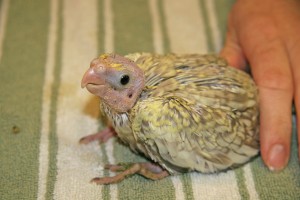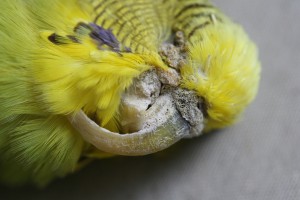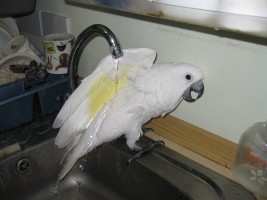The Parrot Society UK
Feather Plucking in Parrots
August 2021 - A UK veterinary student has asked for our help with a survey on the important problem of feather damaging behaviour in pet parrots, from veterinarians dealing with the condition. If you can help Jemima Bland with this vexatious problem, please visit - https://forms.office.com/Pages/ResponsePage.aspx?id=tngUBkJxf0adxCcUECzJJpj11j-FSq9CsRGH59m0BxxUQU1TQlIwSUEwSFJWNDVVSU1CU0RWMUpJQS4u
Feather Plucking in Parrots
by Alan K Jones©
The feature that sets birds apart in the animal kingdom is not the power of flight - other types of animal (e.g. bats) can fly, and some birds are flightless - but instead it is their feathers.
These unique and complex structures give avian species their particular attraction in terms of appearance and colour.
It is perhaps the main reason why people find birds so attractive, and therefore if any problem occurs with the feathers, it is of immediate concern to the pet owner.

African grey parrot in flight (AKJ - picture taken at Whipsnade Zoo, UK)
Just as with any general disease problem in birds, a few displayed symptoms can represent a whole range of causes of the illness, so then there are many reasons why a bird's feathers may become damaged or lost.
These would include inherited defects, dietary deficiencies, infectious diseases and physical damage from the environment or other birds.
To the inexperienced eye, one damaged feather looks much like another, whereas experience and more detailed analysis will hopefully identify the alternative causes.
All of the above problems are of concern to the owner, and require skilful diagnosis to establish the cause and thereby to suggest a possible cure; but there is no more frustrating condition both for the disappointed owner and for the Veterinarian attempting to treat the bird than the Feather Plucker.
The first point to note is that feather plucking is a disease of captivity - it does not occur (except as a natural physiological behaviour in breeding birds) in wild living individuals.
Many owners appear to give their birds the best of care and attention, and yet are rewarded by a bird that rips out all its feathers; whilst other individuals can live in apparently appalling environments and yet have immaculate plumage.
In attempting to investigate a feather-plucking problem, one has to be able to recognise the normal from the abnormal, and to eliminate all other possible causes of feather disease.
This will require detailed questioning of the owner (clinical history) as to the background of the bird - where it came from, where it is kept, how it is fed, when the problem started, how is the problem manifest, are other birds involved etc., etc., etc.
Examination of the environment is important - the presence of parasites or irritants may be detected, plus one can get a general impression of the bird's lifestyle.
The bird will then need a thorough examination, probably linked to laboratory tests such as blood samples to assess liver and kidney function, hormone levels or to check for infectious agents such as Psittacine Beak and Feather Disease (PBFD).
Psittacine Beak & Feather Disease
It may be necessary to examine feather samples or skin biopsies for the presence of bacteria, viruses, fungi or parasites.
It is perfectly normal for a bird to pluck the head and neck feathers of its mate in the breeding season, or for parents to over-preen their chicks in the same way.

Fledgling cockatiel with its head feathers plucked out by its parents (AKJ)
It is also normal for birds to lose feathers over the breast area while breeding (the 'brood patch'), but both these may be triggers to start a bird on the road to longer term plucking.
New feathers that grow in the normal moult will irritate as they come through, and birds will preen heavily at this time, but again the scales can tip easily from preening to plucking if the irritation is excessive, such as would be the case when many feathers are replaced at once.
This can occur following accident or illness, but then a vicious circle is established, because the large number of growing feathers irritates; this leads to plucking, which means more feathers are grown to replace those pulled out, which means more irritation, and therefore more picking, which means......
Certain internal or systemic disease conditions will produce skin irritation that results in plucking.
Liver disease is one; zinc poisoning is often implicated; and Giardiasis in Cockatiels is another. This protozoal intestinal infection is well documented as being a cause of feather picking in the U.S.A, although we tend not to see it so much over here. The remedy in these cases is obviously to treat the underlying disease rather than to try to control the picking.
Dietary problems are also highly significant in feather disease.
Still far too many caged birds are kept on an inadequate or unbalanced diet, and deficiencies of vitamins (especially A), minerals (especially Calcium), trace elements (e.g. Zinc) and amino acids will result in poor feather and skin quality, which in turn predispose to plucking.
In some cases too much of a dietary component can cause a problem - a fat-rich diet or simple obesity will produce poor plumage condition, as will zinc toxicosis (see above).
The bird's environment is extremely important: a smokey or fatty atmosphere such as that associated with a pub, for example, will result in deposits on the feathers that will cause irritation.
Handling a bird with nicotine-stained fingers will irritate a bird's skin and will start a bird pecking to relieve the itch.
A dry, dusty atmosphere is very bad for plumage quality - the feathers will become brittle and will then irritate.
Regular bathing or spraying is essential.
Lighting is important - too long a photoperiod (length of daylight) may tire the bird or stimulate breeding activity or encourage frequent moulting.
Light levels that are too low will result in poor quality feather growth.
Another environmental consideration is boredom.
This is frequently cited as a cause of feather plucking, but in my experience it is by no means the commonest cause.
Parrots are extremely intelligent creatures and do need a lot of physical and mental stimulation to satisfy their needs.
Therefore toys, objects to chew, radios playing, "playtime" with the owner are all important for their wellbeing, and in many cases, the provision of such items where they are not present will prevent plucking in a bird.
However, the opposite situation can also arise - that is to say that a bird's environment can be too busy.
In an active household, with children playing and running around, dogs barking, music blaring, and general busy-ness from dawn 'til well past dusk, the poor bird may get overstimulated and have no chance of proper rest.
This can result in feather plucking and the answer in this case is obviously to move the bird to a more relaxed atmosphere!
In some cases there may be an inability to preen.
The feathers will then look untidy, with persistent sheaths, and they may become secondarily infected, but they will not be plucked out. This could be the case in a hand reared bird that has not been socialised with other birds and has never really learned how to preen; an older bird with painful arthritic joints; or it may result from some damage to the beak which prevents grooming activity.
Specific infections of the skin or feathers may lead to plucking because of the irritation caused.
These would include bacterial infections of the skin (dermatitis) or feather follicles (folliculitis); fungal diseases (similar to diseases such as Athlete's foot, or Ringworm); or virus infections such as PBFD or Polyomavirus.
Parasitic infestations, caused by mites, lice, or ticks Tickscommonly suspected as causes of feather plucking and many cans of mite spray are sold in consequence. In fact, most single pet birds are unlikely to be affected with external parasites, unless they have recently come from a collection. Small aviary and colony birds, such as finches, canaries and budgies, on the other hand, may well be affected by such organisms. One other parasitic condition that is quite common as a cause of skin disease (although rarely feather plucking) is the mange mite Cnemidocoptes (Scaly face, scaly leg, tassle foot).

Severe Cnemidocoptes infestation (Scaly Face) in a budgerigar (AKJ)
Thus to diagnose and treat a case of feather plucking, one has to consider and eliminate or test for all of the above.
Plucking often starts at adolescence, or following some episode of stress.
The time of day that plucking occurs is significant - "situation" plucking in response to something that annoys the bird is common: for example, being put away at night when he doesn't want to go!
Birds are very sensitive to environment and routine: the classic case was the Cockatoo that plucked when its owner moved a picture from one wall in the room to another, and stopped plucking when the picture was replaced!
Jealousy and stress are commonly implicated - having builders in or relatives to stay; holiday times or other changes in routine may all be responsible for starting a bird pulling at its feathers.
The area of feathers that the bird attacks is also significant - chest and shoulder pluckers are most commonly influenced by hormone changes and broody behaviour; whereas a small local area may indicate some underlying internal pain.
In my experience, most cases of plucking that are not the result of one of the disease processes listed above occur in adolescent birds.
Hand-reared African Grey Parrots are perhaps the worst offenders, but Eclectus and Cockatoos come close.
Although birds have been kept in captivity for generations, they are still far from being domesticated species like the dog and cat. The artificial incubation and hand rearing of parrots is a much more recent phenomenon, and these birds grow up not really sure whether they are bird or human! When they reach those "awkward teenage years", and their hormones are telling them they need to breed, they are not quite sure which way to turn and hence start plucking in frustration and confusion. It is also possible that the hormone changes cause direct irritability of the skin, just as in human teenagers with acne.
A commonly suggested solution in such cases is to "get the bird a mate", but this is not always the answer.
A companion bird of a different species may help, but a true opposite sex of the same species may throw the bird into even more confusion, or they may copy each other, and you end up with two plucked birds!
So having identified our bird as a plucker, and confirmed by the above examinations and analysis that it is not suffering from a specific disease, what can we do about it?
I hope I have demonstrated that the causes can be so varied that no one single treatment could possibly work general for every bird, but there are some suggestions that I offer as background therapy in every case.
These are :-
- Regular spraying or bathing with warm water.
This is essential for proper feather condition, especially in an indoor heated atmosphere and should be done several times a week.
Most birds enjoy a shower, but some will actively dislike it.
Nevertheless, one should persevere for the sake of the long-term plumage quality.

Umbrella Cockatoo bathing under a tap in the kitchen sink (AKJ)
- The provision of a stimulating and interesting environment, including materials that can be chewed.
There are many parrot toys available which are useful, but these can be expensive.
It is just as effective to provide cheap replaceable objects such as clean twigs from non-toxic trees (fruit trees, willow, hazel, chestnut, eucalyptus, etc..); cardboard egg boxes or rolls; hide chews intended for dogs; or similar.
Birds need to chew, and these items may be destroyed and replaced on a regular basis, and may distract the bird from destroying its own feathers.
Leaving a radio or television playing when the house is empty can be useful, but balance this with what I mentioned earlier about an over-noisy environment.
It may help to move the bird around to be with the family at different times of the day, but conversely other birds fare much better if their housing is stable, and they can feel safe and secure.
Each case has to be treated as an individual.
The provision of a well-balanced diet.
This is very important, and many cases of poor feather quality will be improved with better nutrition.
Fussy eaters can be given one of the many vitamin and mineral supplements that are available, but of particular importance to feather growth are the amino acids to be found in animal protein.
Many people seem surprised to be told that their pet birds should be given such items as hard cheese, cooked egg or chicken, fish fingers etc., 2 or 3 times a week, but in fact the protein content of these foods is essential for new feather growth.
Wild parrots are facultative omnivores, which means they will eat anything that is available in their environment, including the occasional grub, caterpillar, insect or even small fish, so animal protein is not at all alien to their diet.
Other remedies that may be adopted in specific cases could be the judicious use of hormone therapy, or the provision of a proper environment in which to pair off and breed.
Many other suggested methods really just attack the results of the plucking, and do not address the root cause.
These would include the use of sedatives or psycho-altering drugs such as the much publicised "Prozac".
These may have a place and a short term effect in some cases, but usually once therapy is withdrawn, the plucking will recur if the bird's circumstances are unchanged.
Previously advised techniques such as notching of the beak, or applying a ball to its tip to prevent the bird damaging its feathers have now been abandoned, but collars may be attached to restrict plucking. Again, these methods are preventive rather than curative, but may have a place in allowing feather recovery while the underlying reasons are addressed. The fitting of collars is a personal preference: in my experience many birds are adept at removing them, or if they can't, then they become even more neurotic.
In summary, one can repeat that there is no overnight solution, and that there is no single remedy suitable for all cases.
Detailed "psychoanalysis' is required for each bird (and very often its owner!), and even then there will be many disappointments. It will take weeks to correct a problem and establish new feather growth, but only a few minutes for a recalcitrant bird to pull them all out again!
Many cases do relapse and with repeated plucking there may well be permanent follicular damage that means the bird will never grow feathers in these areas. Parrots are intelligent creatures and require both mental and physical stimulation to keep them fit.
This they have in their natural wild environment, so I repeat that feather plucking is a disease of captivity.
Each case presents a challenge to owner and Veterinarian and every attempt must be made to resolve the underlying problem rather than merely to suppress the urge to pluck.
© Alan K. JONES April 1995, updated 2018
Useful Link - feather plucking and nutritional advice from The Birdcare Company
